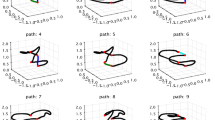Abstract
In modeling human and primate motor behavior, optimization has been used to mathematically describe hand trajectories during reaching movement, with the duration of the movement given as part of the boundary conditions. As duration is an input to the model rather than an output, a description is lacking of how the duration depends upon the circumstances of the movement. In the present work, we extend a minimum jerk model of reach trajectory planning to include a penalty for duration and show that it can be used to quantify the trade-off between quickness and effort in reaching movements. We then show that a given trade-off for a nominal reaching movement can predict the duration of related movements, specifically reaching movements subject to perturbation of the target during their course. The mathematical model is tested against several independent bodies of experimental data.
Similar content being viewed by others
References
Bizzi E, Accornero N, Chapple W, Hogan N (1984) Posture control and trajectory formation during arm movement. J Neurosci 4:2738–2744
Feldman AG (1986) Once more on the equilibrium-point hypothesis (λ model) for motor control. J Motor Behav 18:17–54
Flash T (1987) The control of hand equilibrium trajectories in multijoint arm movements. Biol Cybern 57:257–274
Flash T, Hogan N (1985) The coordination of arm movements: an experimentally confirmed mathematical model. J Neurosci 5:1688–1703
Georgopoulos AP, Kalaska JF, Massey JT (1981) Spatial trajectories and reaction times of aimed movements: effects of practice, uncertainty, and change in target location. J Neurophysiol 56:725–743
Hoff B, Arbib MA (1992) A model of the effects of speed, accuracy and perturbation on visually guided reaching. In: Caminiti R (ed) Control of arm movement in space: neurophysiological and computational approaches. (Experimental Brain Research Suppl 22) Springer-Verlag, Berlin, pp 285–306
Hoff B, Arbib MA (1993) Models of trajectory formation and temporal interaction of reach and grasp. J Motor Behav 25:175–192
Hogan N (1984) An organizing principle for a class of voluntary movements. J Neurosci 4:2745–2754
Paulignan Y, MacKenzie C, Marteniuk R, Jeannerod M (1991) Selective perturbation of visual input during prehension movements. 1. The effects of changing object position. Exp Brain Res 83:502–512
Pélisson D, Prablanc C, Goodale MA, Jeannerod M (1986) Visual control of reaching movements without vision of the limb. II. Evidence of fast, unconscious processes correcting the trajectory of the hand to the final position of a double-step stimulus. Exp Brain Res 62:303–311
Stark L (1968) Neurological control systems, studies in bioengineering. Plenum Press, New York
Author information
Authors and Affiliations
Rights and permissions
About this article
Cite this article
Hoff, B. A model of duration in normal and perturbed reaching movement. Biol. Cybern. 71, 481–488 (1994). https://doi.org/10.1007/BF00198466
Received:
Accepted:
Issue Date:
DOI: https://doi.org/10.1007/BF00198466




